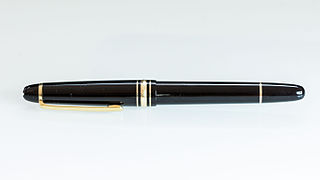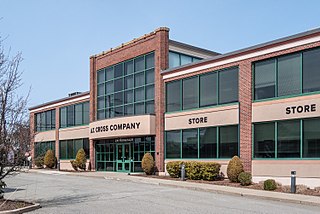
A ballpoint pen, also known as a biro, ball pen, or dot pen, is a pen that dispenses ink over a metal ball at its point, i.e., over a "ball point". The metal commonly used is steel, brass, or tungsten carbide. The design was conceived and developed as a cleaner and more reliable alternative to dip pens and fountain pens, and it is now the world's most-used writing instrument; millions are manufactured and sold daily. It has influenced art and graphic design and spawned an artwork genre.

A fountain pen is a writing instrument that uses a metal nib to apply water-based ink, or special pigment ink—suitable for fountain pens—to paper. It is distinguished from earlier dip pens by using an internal reservoir to hold ink, eliminating the need to repeatedly dip the pen in an inkwell during use. The pen draws ink from the reservoir through a feed to the nib and deposits the ink on paper via a combination of gravity and capillary action. Filling the reservoir with ink may be achieved manually, via the use of an eyedropper or syringe, or via an internal filling mechanism that creates suction or a vacuum to transfer ink directly through the nib into the reservoir. Some pens employ removable reservoirs in the form of pre-filled ink cartridges.

A pen is a common writing instrument that applies ink to a surface, usually paper, for writing or drawing. Early pens such as reed pens, quill pens, dip pens and ruling pens held a small amount of ink on a nib or in a small void or cavity that had to be periodically recharged by dipping the tip of the pen into an inkwell. Today, such pens find only a small number of specialized uses, such as in illustration and calligraphy. Reed pens, quill pens and dip pens, which were used for writing, have been replaced by ballpoint pens, rollerball pens, fountain pens and felt or ceramic tip pens. Ruling pens, which were used for technical drawing and cartography, have been replaced by technical pens such as the Rapidograph. All of these modern pens contain internal ink reservoirs, such that they do not need to be dipped in ink while writing.

A dip pen is a writing instrument used to apply ink to paper. It usually consists of a metal nib with capillary channels like those of fountain pen nibs, mounted in a handle or holder, often made of wood. Other materials can be used for the holder, including bone, metal and plastic; some pens are made entirely of glass.

The Parker Pen Company is an American manufacturer of luxury writing pens, founded in 1888 by George Safford Parker in Janesville, Wisconsin, United States. In 2011 the Parker factory at Newhaven, East Sussex, England, was closed, and its production transferred to Nantes, France.
Waterman Philéas is a series of writing instruments including fountain pens, rollerballs, ballpoints and pencils produced by the Waterman pen company. It is well-known because of its good price-quality ratio and is therefore often recommended for novice fountain pen users and collectors. This series is now discontinued.

Staedtler Mars GmbH & Co. KG is a German multinational stationery manufacturing company based in Nuremberg. The firm was founded by J.S. Staedtler (1800–1872) in 1835 and produces a large variety of stationery products, such as writing implements, art materials, and office supplies.
A writing implement or writing instrument is an object used to produce writing. Writing consists of different figures, lines, and or forms. Most of these items can be also used for other functions such as painting, drawing and technical drawing, but writing instruments generally have the ordinary requirement to create a smooth, controllable line.

Meisterstück is the flagship line of pens from luxury brand Montblanc.

Rotring is a manufacturer of technical drawing tools and writing implements. Established in Germany in 1928 as a fountain pen manufacturer, Rotring went on to be acquired by Newell Brands in 1998. The name "Rotring" directly translates to "red ring" which is still placed around the barrel of their pens today. The company's name was changed to Rotring in the early 1970s to match the trademark.

Faber-Castell AG is a manufacturer of pens, pencils, other office supplies and art supplies, as well as high-end writing instruments and luxury leather goods. Headquartered in Stein, Germany, it operates 14 factories and 20 sales units throughout the globe. The Faber-Castell Group employs a staff of approximately 8,000 and does business in more than 120 countries. The House of Faber-Castell is the family which founded and continues to exercise leadership within the corporation. Faber-Castell manufactures about 2 billion pencils in more than 120 different colors every year.
Lamy is a German pen manufacturing company. Josef Lamy, who was a sales representative for Parker Pen in Germany, founded the business in 1930 by purchasing the Orthos pen manufacturer. Lamy was a pioneer in the use of moulded synthetic plastics to make their products.

Pilot Corporation is a Japanese pen manufacturer based in Tokyo, Japan. It produces writing instruments, stationery and jewelry, but is best known for its pens.
Uni-ball and Uni are brands of pens and pencils, made by the Mitsubishi Pencil Company Limited of Japan. The brand was introduced in 1979 as a rollerball pen model, then expanding to the rest of Mitsubishi Pencil products.

Zebra Co., Ltd. is a Japanese manufacturer of writing instruments, established in 1914 by Tokumatsu Ishikawa.

A.T. Cross Company, LLC. is an American manufacturing company of writing implements, based in Providence, Rhode Island. Founded in 1846, it is one of the oldest pen manufacturers in the world. Cross' products include fountain, ballpoint, and rollerball pens, mechanical pencils and refills. The company also manufactures accessories for those goods such as cases and wallets.
Ballograf AB is a Swedish manufacturer of writing implements. Ballograf manufactures its products from raw materials to finished product in its factory in Västra Frölunda, Gothenburg.
The Sheaffer Prelude fountain pens, rollerball pens and ballpoints are a line of writing instruments made by the Sheaffer Pen Company.













